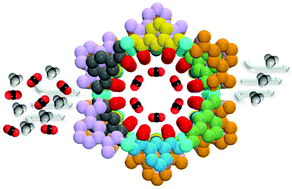A chiral metal–organic framework with polar channels: unique interweaving six-fold helices and high CO2/CH4 separation†
Abstract
A chiral Cu(II) metal–organic framework, [H2N(CH3)2]2[Cu(L)]·5.5DMF (1), was constructed using a diisophthalate ligand with an active pyridyl site, 2,6-di(3′,5′-dicarboxylphenyl)pyridine (H4L). The structure possesses interesting polar channels based on interweaving heterochiral [4 + 2] helices, which contains multiple CO2 binding sites, leading to highly selective capture of CO2 over CH4. Grand canonical Monte Carlo simulations identified the multiple adsorption sites in 1 for CO2.


 Please wait while we load your content...
Please wait while we load your content...